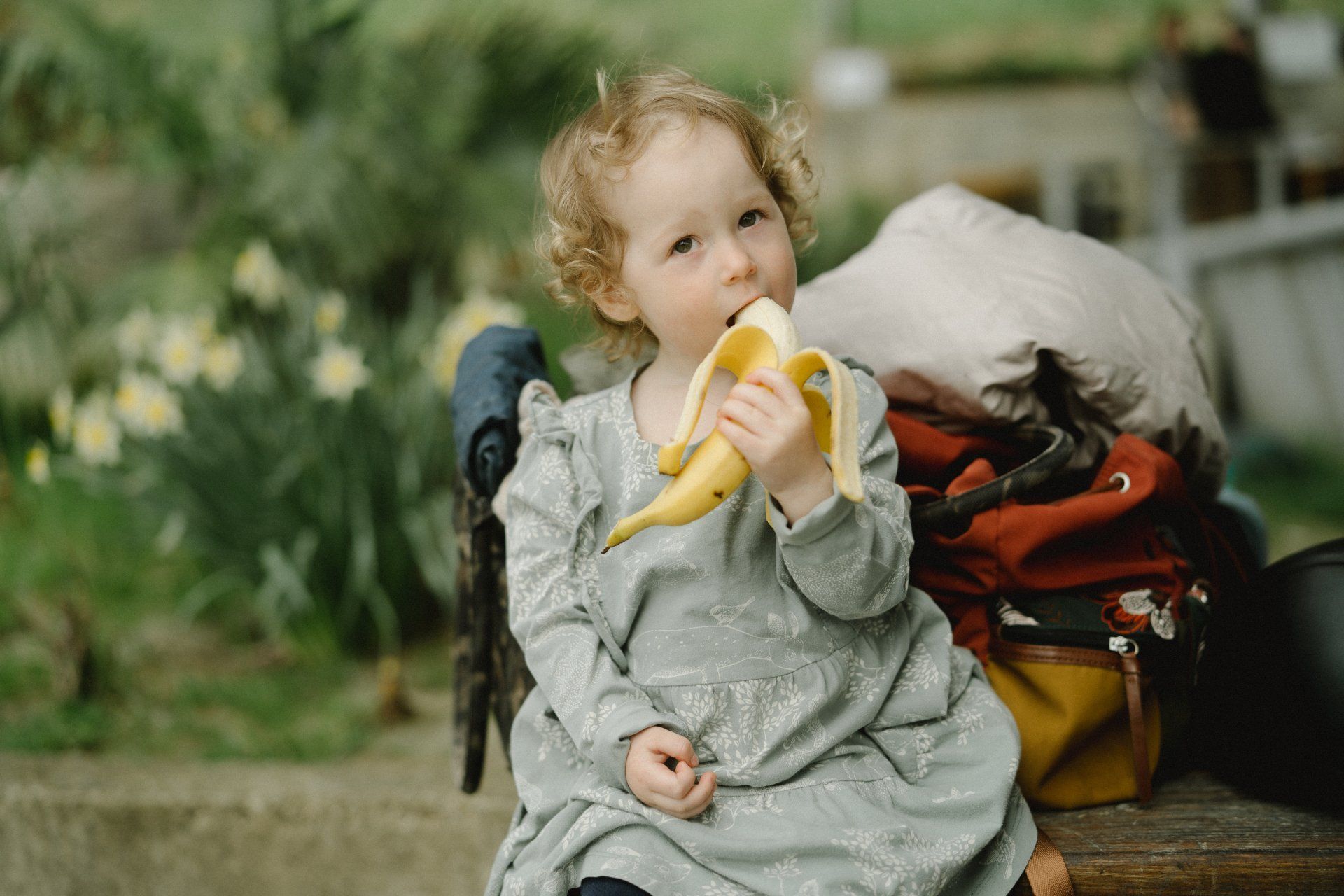Developmental Feeding Milestones

Developmental Feeding Milestones
By Kimberly Spair, Speech/Language Pathologist from Reclaimers of Health and guest Melissa McDonald, Speech/Language Pathologist and Certified Lactation Counselor
We wanted to take the opportunity to collaborate on this blog in order to share our personal and professional experiences related to developmental feeding. We hope you walk away having learned something new.
As most RoH clients and followers know, we strive to make the lives of moms (and dads, of course) easier in any way that we can. One area in which we provide a lot of support to our clients is with the feeding skills of little ones—during infancy and beyond. As such, today we wanted to share some information about developmental milestones as it relates to swallowing and feeding.
Let’s Start at the Beginning (0-6 months)
At 0-3 months, babies are fed solely by breast and/or bottle. They have oral reflexes for suckling and swallowing, and the coordination of suckling, swallowing, and breathing is key to successful feeding. Even at this early age, babies should be able to close their lips to seal their mouths. At first, they should be lying down cradled in their caregiver’s arms to eat (at approximately a 45-degree angle), then as their swallow matures, the changing of feeding positions can be considered.
4–6-month-old babies begin sucking (this action involves more of an up and down movement) and are no longer only suckling (the reflex that involves a front to back movement of the tongue). It’s around this time that the action of breast or bottle feeding becomes less automatic and more voluntary and this is also when the tongue thrust and rooting reflexes should begin to subside. Believe it or not, babies can start drinking from a small open cup from about 4–6 months of age. We dive into this a bit more later in this post.
“Solid food” Introduction! (6 months or later)
The American Academy of Pediatrics recommends “exclusive breastfeeding for approximately 6 months” as well as to “introduce solid foods around 6 months of age.” We agree that 6 months is the very EARLIEST to begin considering playing with solid foods, but as we always advise our clients, also let YOUR baby guide your decision making. (For the record, we also recommend that moms continue their breastfeeding journeys as long as both mommy and baby are happy!)
Watch for the following signs to indicate solid food readiness:
- Baby can sit up with little or no support, and has good head control. ( Note : Once babies can sit, their feet should be touching something (the floor, a step, etc.). This is important because if a child isn’t positioned correctly, he/she may have more difficulty swallowing, and thus be more likely to choke.)
- Baby has lost the tongue-thrust reflex and does not automatically push solids out of his mouth with his/her tongue.
- Baby opens his or her mouth and leans forward when food is offered.
It goes without saying that if a child does not exhibit the above signs of readiness, is experiencing any obvious feeding problems, or if a parent feels that the child is not ready for solid foods, by all means, wait!
Babies can absolutely survive and thrive on breast milk through their entire first year of life. We love the saying “food before one is just for fun” for this exact reason!
Many of our clients report feeling pressured or rushed by family members or care providers to start solid foods from 4-6 months. We absolutely encourage mommas to make the best decision for their babies which may mean starting at 6 months or even waiting until 9 months or closer to a year old to introduce food.
Gagging Versus Choking
It may give peace of mind to know that a parent might see occasional gagging (e.g., coughing, gurgling) as a baby is learning to eat a variety of new foods, especially in the first year of life.
If there are no signs of choking (e.g., high pitched sounds when breathing or even silence due to partial or total blockage of the windpipe), it’s advised to just wait a few seconds and closely and calmly monitor. If the baby remains calm and continues eating, parents and baby can happily carry on (while parents always remain vigilant). The gag reflex is actually a perfectly normal and instinctual defense against choking.
First Foods
There are lots of opinions out there about what foods to offer when one starts to give baby foods, AKA “table foods.” This leaves moms wondering if they should start with pureed foods, finger foods, mashed foods, raw foods, or if they should cook first foods.
Generally speaking, babies are meant to eat solid foods once their teeth and molars have developed and they can chew since this indicates the gut has been developed enough to digest chewable foods. Until the teeth come in, yummy foods can still be pureed or put in smoothies and easily enjoyed. Check out this post on some of our favorite and recommended first foods for babies for more ideas. We also discuss this topic much more in our course Empowered Moms , and the spring 2020 group session launches April 6th.
Utensil Use & Sippy Cups
Our advice is to not worry about utensils at this stage. We find that letting your child use his/her fingers to pick up food presented on a tray is the best way to start; it’s less distracting when first learning to eat. Drinking from an open cup and/or straw can be introduced during this time as well, but we have one major piece of advice:
Just say “no” to sippy cups.
It seems like the norm these days to go from bottle to “sippy cup.” It makes sense on a surface level…tight lid + fewer openings = fewer spills, so that much I understand. Sadly, the sippy cup was invented in order to help ADULTS, not the young children using them (or their oral motor skills).
We need to consider that most traditional sippy cups get in the way of our sweet babies’ development. This is because a sippy cup keeps the baby’s tongue down while simultaneously preventing the tongue from moving up. Basically, the use of a sippy cup requires the same type of sucking motion that babies use with breast and bottle feeding since the spout is just like a nipple. As a result, sippy cups prolong the use of the less mature swallowing pattern, resulting in difficulties with chewing and swallowing as the kids expand their repertoires. (These cups can also impact speech and language skills, as well as impact oral musculature and could lead to breathing difficulties and a need for braces, among other issues.) Most sippy cups are also typically made of plastic so that’s one more strike against them.
Rather than using a “sippy,” we recommend allowing your little one to learn how to use a straw early on in his/her drinking. You can also allow your child to practice sipping/cup drinking from a “shot glass” sized cup. As we mentioned earlier in the post, babies can start drinking from a small open cup from about 4–6 months of age. Of course, if you are starting this young, make sure that you are using breast milk or the child’s “formula” only.
Learning to drink from a cup will likely get messy as your child is first learning, so this would be a fun activity to try during bathtime, or while outside. It’s also best to teach this skill when you have plenty of time, and you’re not in a hurry. He/she will need some help with gently guiding the cup at first, but you’ll be surprised how most children are sipping on their own in no time.
10–24 Months
By 10–12 months, your baby should be able to eat small pieces of soft food, move food from side to side in the mouth, and begin to chew food in a circular manner.
As his/her pincer grasp develops (when a child pinches an object or piece of food with his/her thumb and index finger), he/she will start to use a spoon, but will often opt to self-feed with his or her hands. Regarding drinking, at this age, your baby should be able to curve his/her lips around the rim of a cup and drink with little spilling.
During 12–18 months of age, your child should be able to use utensils proficiently for self-feeding. Depending on teeth, he/she should be able to bite through harder foods as well.
By 18 months, your child should be capable of chewing with lip closure (even if he/she doesn’t always do so), but even when his/her lips are open no significant amount of food or liquid should be lost while eating and drinking.
By 19–24 months, your child should be able to chew and eat most foods, although it is still recommended that caregivers cut foods that can be choking hazards (think grapes) into smaller pieces to avoid choking, especially since toddlers are known for moving and playing, even while eating. Your child should be able to eat with his/her mouth closed and drink from a cup proficiently without spilling too often.
When to Be Concerned About Your Child’s Feeding
The following are signals that you may want to further investigate your child’s feeding and/or swallowing:
- Mealtimes are stressful.
- Mealtimes take more than 30 minutes.
- Your child has not gained weight in the past 2–3 months
- Your child shows signs of respiratory distress.
If you are noticing any of the above signals and/or your instinct is telling you that something just isn’t right, please address these concerns with your pediatrician and/or seek assistance from an SLP (Speech-Language Pathologist).
Product Recommendations
Now that we have presented what is typical as far as developmental feeding goes, we wanted to share some of our favorite non-toxic products to support you further.
Generally speaking, when it comes to dishes for your little one (and your whole family really), you want to avoid plastic anything (this includes baby bottles as well as cups and dishes). A brand for kids that we LOVE is Green Sprouts. They make their items so you’re “safer from the inside out” and have a variety of options such as cups, bottles, plates, utensils, and storage containers (as well as bibs, placemats, burp cloths, teething toys, and other safe items!).
Check out this post on limiting toxins with plastic-free food storage for more recommendations.
Feeding Issues/Sensitivities?
If your baby or toddler needs special care/attention paid to his or her diet, as in the case of allergic reactions and food allergies, check out this post on food allergies and foods to focus on and eliminate.
Further Support on Feeding & Kids
For further assistance with food allergies, food refusal, or sensory-based feeding difficulty, check out the Empowered Moms course which goes into all of these topics and more. The course launches for its fourth round on April 6 and is now $100 off for a limited time .
Returning moms can retake the course with the group for $60 by using code EMSISTERHOOD .
The post Developmental Feeding Milestones appeared first on Reclaimers of Health.

